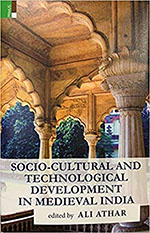Socio-Cultural and Technological Development in Medieval India edited by Ali Athar brings together thirteen articles focusing on the sub-themes: literary sources; state and administration; society and culture; science and technology.
Some articles in the book offer insightful discussions, particularly those on 18th century north India. The article by Rohma Javed Rashid, for example, engages with the shahr ashob poetry that used humour, satire and dramatized language to lament the dwindling fortunes of the elite and rise of lower social groups in 18th century Shahjahanabad, meant to convey the decline of the city. It adds to the scholarship by Raziuddin Aquil, Abhishek Kaicker and others on Mughal Delhi in the 18th century. The articles by KL Mathur and Jibraeil give insights into the intersection of technology and state in Rajasthan. Mathur’s article examines the transformation of the State of Bikaner in the 18th century resulting from the breakdown of Mughal control over the region. It argues that the decline of the Mughals improved metal technology in the region, as artisans shifted from Delhi to the State of Rajasthan. It, however, does not explore the artisanal communities engaged in metal production and the reimagining of social practices resulting from their rising economic status in 18th century, a theme explored by Nandita P Sahai. Jibraeil’s article offers an insightful review of artificial irrigation works (kohars, kuan, talabs) in Phalodi district of Jodhpur State to underscore the water harvesting and management system in a region with water scarcity. The author, however, does not expand on his conclusion that Palliwal Brahmins were knowledgeable about water management.
The essays by Tasneem Suhrawardy and Firdos Anwar offer important discussions on the nobility and political traditions under the Mughals. Suhrawardy traces the changes in Mughal courtly culture, particularly the decline of Central Asian rituals and practices, as the Court was increasingly being Persianized. Anwar examines the composition of nobility under Shahjahan, studying the reign against the backdrop of his Deccan campaigns.

